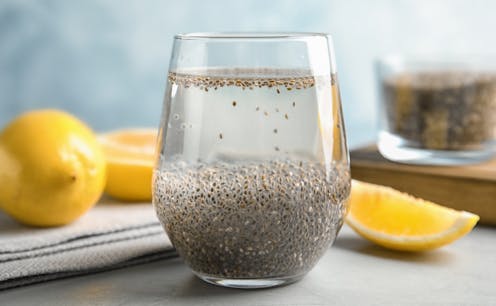Does TikTok's chia-lemon 'internal shower' really beat constipation? Here's what science says
- Written by Clare Collins, Laureate Professor in Nutrition and Dietetics, University of Newcastle

Heard about the chia seed-lemon juice “internal shower” drink? It’s going viral on TikTok and is being hailed as a digestion booster, constipation and bloating buster (particularly after travelling), detox drink and hangover cure.
Advocates recommend you mix two tablespoons of chia seeds in a cup of water, add lemon juice, wait till the seeds start to absorb the water and form a gel, drink it on an empty stomach, and wait.
Chia seeds are edible seeds from a flowering plant of the mint and sage families. These tiny seeds (1,000 seeds weigh about 1.3 grams), pack a nutritional punch and are rich in dietary fibre, polyunsaturated fat and protein. They also contain B vitamins (thiamin, riboflavin, niacin and folic acid) and minerals (calcium, potassium, magnesium and phosphorus).
Before you rush out to get some chia seeds, be wary. The National Capital Poison Center in the United States urged caution, following the case of a person needing surgery after the gelled chia seeds became stuck and blocked his oesophagus.
Let’s break down the ‘internal shower’ claims
1) Digestion booster
Chia seeds can’t “boost” digestion. For most people, digestive processes run automatically, just like breathing and blood flow. So you can’t speed up the enzymatic processes that help with food breakdown, digestion and absorption.
This claim is likely to be mixed up with constipation, which affects the time in takes for undigested food to travel though your gut and to your large bowel where it gets processed and turned into poo.
There are medical conditions, such as cystic fibrosis, where digestive enzymes can’t mix with food adequately and medicinal enzymes have to be taken orally. But this is very rare.
2) Constipation buster
This claim is likely to be true, due to the very high fibre content of chia seeds.
Dietary fibre content of chia seeds varies from 23% to 41%, depending on the variety. Of that, 85% is insoluble fibre that adds bulk to stools and helps increase the transit time of bowel motions through your intestines. The other 15% is soluble fibre, meaning that it dissolves in water and remains intact until it gets to the large bowel. There, it is fermented by the gut microbes. This produces water that helps to keep your bowel motions soft.
Two tablespoons of chia seeds weigh about 20-25 grams, providing 9-10 grams of fibre, which is a lot compared to adult daily intake targets of 25-30 grams per day.
But chia seeds aren’t the only fibre-rich food.
So what are the signs you need to have a closer look at your diet?
If, over the past few months, you have experienced symptoms including lumpy or hard stools, incomplete emptying of bowels, straining to pass a bowel motion or having fewer than three bowel motions per week, you could be constipated.
Authors: Clare Collins, Laureate Professor in Nutrition and Dietetics, University of Newcastle





